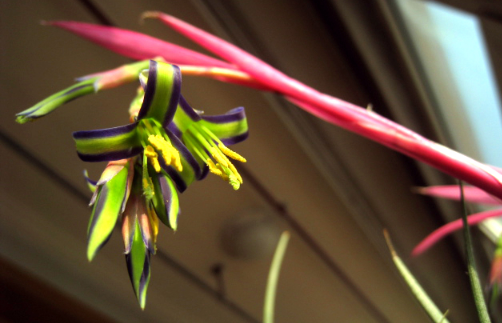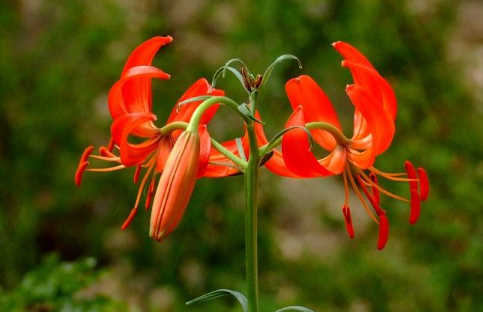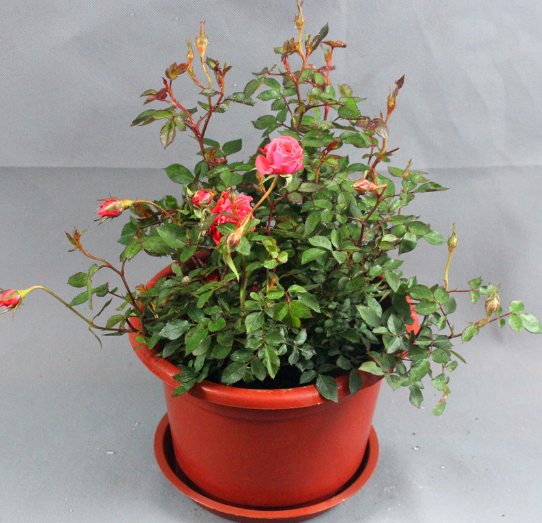The Propagation method of Flos Lonicerae
1. Tissue culture
Tissue culture method was used for mass propagation of commercial cultivars. The stem apex tissue of tiller buds was used as material. Adventitious buds could be formed in 30~40 days after inoculation on MS medium supplemented with 6-benzylaminoadenine 4 mg/L and indoleacetic acid 0. 1 mg/L after routine disinfection.

2. ramets
The propagation of water tower flower is often carried out in spring. The mother plant can take out tiller buds before and after flowering or between leaves, while the mother plant can not continue to grow and die. The tiller buds can be used for propagation and cuttage propagation. The rooted tiller buds can be directly put into the pot.
3. Cutting
Cuttage propagation of Hydra pendula is often carried out in spring, and the survival rate of ramets is low during high temperature period. When cutting, cut off the tiller buds when they are 8~10 cm long, insert them into the substrate of rotten leaf soil and coarse sand, keep the room temperature at 25~28℃, take root for about 30~40 days, and cultivate them in pots for 50~60 days. The mother plants with broken tiller buds can grow 2~3 batches of tiller buds after cultivation.
After reading this article, are you surprised that the hanging flower water tower flower has these functions? Do you feel that you have raised a pot of expensive hanging flower water tower flower?
1. Temperature of water tower flower
It likes warm climate and grows at a suitable temperature of 21-27° C. It belongs to a species with strong adaptability to temperature and can withstand low temperatures of 2-5° C. In South China, it can overwinter in the open field, but in the north area, it is necessary to move indoors to keep warm during overwinter, and cover the plants with plastic bags during cold spell to prevent cold damage. In the hot summer, ventilation should be strengthened to drive away the sultry heat.
2. Light
Like half shade, avoid strong sunlight exposure. When the light is too strong, the leaves will turn yellow or even burn and appear focal spots. 5, September to shade, shade 50%-70% of the light, or set sufficient light place. The rest of the year requires plenty of sunlight.
3. Watering
Like wet soil conditions, pot soil too dry will make leaf tip withered coke, and plant growth is poor. During the growth period should be sufficient supply of water, keep the basin soil moist; but avoid too wet and ponding, so as not to rot roots.
4. Fertilization
Before flowering in spring, applying fertilizer combined with phosphorus and potassium fertilizer for 1-2 times can make flowering large and fresh. After flowering, the plant does not require high fertilizer requirements, generally do not need fertilizer, only in the plant due to lack of fertilizer and growth thin, only appropriate topdressing nitrogen-based fertilizer. Stop fertilizing in winter.
The above is about how to raise the problem of hanging flower water tower flower introduction, below we take a look at how long it takes to flower hanging flower water tower flower.
Billbergia nutans Billbergia nutans The leaves are sword-shaped, hard, with fine teeth. Inflorescences slender, spikes, with several large rose-red bracts. It is cold resistant and can withstand 2℃ low temperature for a short time. Generally, plants with a diameter of more than 8 cm or 3 years after cultivation can bear fruit. Seed can be collected and sown for reproduction, high emergence rate, easy management of young stage, suitable for potted viewing. Water tower flower is bromeliaceae water tower flower, perennial evergreen herbs, small pineapple, often multi-plant cluster. The plant is rosette shaped and consists of 12 - 15 leaves. Morphological characteristics of water tower flowers with pendulous flowers. Leaves rosette, up to 50 cm, 15 mm wide, apex pendulous, leaf margin sparsely spinulose; scape 30 cm long, apex pendulous, 4-12-flowered, glabrous, rachis geniculate; involucral bracts narrow, clinging to scape, pink to reddish; calyx 3, 1.3-2.7 cm long, orange-red, margin blue-purple, petals 3, 3.6-4 cm long, green, margin blue-purple, apex acute, reflexed; stamens 6; Anthers 7 mm long, protruding outside flowers; ovary inferior, green, 1 cm long, placentation axile, stigma twisted. Seeds are mostly small. Our greenhouse often cultivated for viewing. Originated in Brazil. Water tower flower is a perennial evergreen herb belonging to water tower flower of bromeliaceae. It is a small pineapple with many plants clustered. The plant is rosette shaped and consists of 12 - 15 leaves. Leaves sword-shaped or narrowly lanceolate, hard, dark green, abaxially covered with white scales, powdery, margin serrate. Spring flowering, scape from leaves out, spikes arched pendulous, ca. 30 cm long, bracts rose red, corolla yellow-green, blue margin. The ecological habit of water tower flower is cold-resistant and can withstand 2℃ for a short time. The cultivation techniques of water tower flower (1) Temperature: likes warm climate, suitable temperature for growth is 21~27°. In ornamental pineapple, it belongs to the category with strong adaptability to temperature and can withstand low temperature of 2~5°. In South China, it can overwinter in the open field, but in the north area, it is necessary to move indoors to keep warm during overwinter, and cover the plants with plastic bags during cold spell to prevent cold damage. In the hot summer, ventilation should be strengthened to drive away the sultry heat. (2)Light: like half shade, avoid strong sunlight exposure. When the light is too strong, the leaves will turn yellow or even burn and appear focal spots. From May to September, the ship runs shade, blocking 50%~ 70% of the light, or places with sufficient light. The rest of the year requires plenty of sunlight. (3)Watering: like wet soil conditions, pot soil too dry will make leaf tip withered coke, and poor plant growth. During the growth period should be sufficient supply of water, keep the basin soil moist; but avoid too wet and ponding, so as not to rot roots. (4)Environmental humidity: like to grow in an environment with high air relative humidity, the air relative humidity is best maintained at 85/. Above. When the relative humidity of the air is high, the plants will show a bright and oily luster. When the air is dry, the plants become dull and dull, and the leaves thin and lifeless. During the growth period, especially when the air is dry, it is necessary to spray water to the surrounding environment frequently to make the air moist. When the temperature is low in winter, plastic bags can be put on the pots, which can keep warm and maintain appropriate air relative humidity, thus contributing to the growth of plants. (5)Fertilization: 1~2 times of phosphorus and potassium fertilizer combination before flowering in spring| 1, can make flowers large and bright. After flowering, the plant does not require high fertilizer requirements, generally do not need fertilizer, only in the plant due to lack of fertilizer and growth thin, only appropriate topdressing with nitrogen-based fertilizer. Stop fertilizing in winter. (6)Pruning: after the flowers fade, the flowering branches should be cut off in time to facilitate the germination of new buds. (7)Turn over pot: When the pot is not turned over for many years, the plant is not easy to sprout, and the plant cluster is easy to age, and the growth potential becomes worse. The pot should be turned once every 1~2 years, and the pot should be turned after flowering. The substrate can be prepared by 1 part of peat soil, 1 part of vermiculite, 0.5 part of pearlite, or 1 part of peat soil and 1 part of tree fern. The disease control of water tower flower with pendulous flower rarely occurs. Only in the air relative humidity is low, not ventilation easy to breed red spider, scale insect harm. Common problems in cultivation 1. Leaf tip withered: ① air is too dry;② insufficient watering makes the pot soil too dry. Root rot or stem rot: often caused by excessive watering, especially in winter when low temperature and wet more easily produced. The reproductive mode of pendulous water tower flower reproduces ramets and sows. (1)Plant division: after flowering, combine with pot turning, divide the clustered plants into several clusters with a sharp knife. The new plants should not be small, and each cluster should have at least two mother plants with 1~2 daughter plants. The new plants are small, although they can survive, but the plant shape is not beautiful. After cutting, smear sulfur powder or plant ash on the wound, and then put it in the basin respectively. The new plants can flower in the second year after planting. (2)Sowing: immediately after the fruit matures, after removing the pericarp and washing, the seeds are sown in the substrate, covered with glass or plastic bags after pouring enough water, maintained at a temperature above 20° C, and generally germinated after 1~2 weeks. Sowing seedlings need to be cultivated for 3 years before flowering, so they are rarely used. The garden use of hanging flower water tower flowers hanging flower water tower flowers like orchids, flowers when colorful, very beautiful. Both considerable leaves, but also considerable flowers, but also strong nature, easy to cultivate, suitable for family cultivation. The role of the water tower flower is ornamental and health care. The water tower flower is a sedum acid metabolism (CAM) plant, which should be placed in the bedroom or study to keep the indoor air fresh. Water Tower Flowers
- Prev

Culture method of Salvia officinalis L.
1. The main purpose of planting time is to plant bulbs, which are usually planted in autumn, and the seeds can be stored in sandy soil before planting. two。 Shandan flowers like the sun. Pay attention to receive light after planting balls sprout and ensure more than 6 hours of light every day. 3. Water Shandan flowers like to be moist
- Next

Matters needing attention in rose culture
1. Anti-freezing. Rose has a strong cold tolerance, which can withstand the low temperature of-10 ℃. Generally speaking, the south can be placed directly under the eaves facing south for the winter, while the northern potted rose moves inward to indoor ventilation when the temperature drops to 10 ℃. It should be noted that do not prune the flowers after they have withered in October.
Related
- Fuxing push coffee new agricultural production and marketing class: lack of small-scale processing plants
- Jujube rice field leisure farm deep ploughing Yilan for five years to create a space for organic food and play
- Nongyu Farm-A trial of organic papaya for brave women with advanced technology
- Four points for attention in the prevention and control of diseases and insect pests of edible fungi
- How to add nutrient solution to Edible Fungi
- Is there any good way to control edible fungus mites?
- Open Inoculation Technology of Edible Fungi
- Is there any clever way to use fertilizer for edible fungus in winter?
- What agents are used to kill the pathogens of edible fungi in the mushroom shed?
- Rapid drying of Edible Fungi

